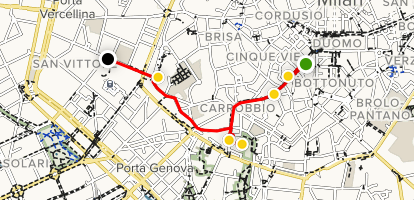
S. Maria Annunciata in Camposanto And More of Milan
The name “Camposanto” is due to the initial role of the structure, or that of a cemetery. For this reason, the Veneranda Fabbrica began, in 1395, the construction of a cemetery, which provided for the construction of a portico resting on the apse pillars of the Duomo, where, until that time, the housing of the construction workers were located. For the milan toursthis is essential.
The name “Santa Maria” instead, is due to a large legacy made by a devotee of Maria Santissima, for the construction or in the Duomo or in Camposanto, of a chapel with the right of burial for himself and his heirs. Finally the toponym ” Annunciata,” owes its origins to a miracle: under the arcades of Camposanto, waiting to be placed inside the Cathedral, a marvelous bas-relief depicting a scene of the Annunciation had been placed. One day a sick man stopped to pray before the ‘effigy and obtained instantaneous healing, pushing the Veneranda Fabbrica to give it a prominent place in the building under construction, dedicated then to S. Maria Annunciata. In February 1661, the Camposanto lost its function of the cemetery, for becoming the church where the Fabbriceri attended the Holy Mass.
Baptistery of S. Stefano

For access restricted to men only, the baptistery was the place where, in 387, Ambrose baptized Augustine of Hippo. The remains were discovered between 1961-62, at a lower level than the Cathedral floor of about 3.8 meters, during excavations for the construction of the underground. Inside the octagonal basin, located at a level of 4.50 meters from the floor, traces of marble covering and a water conduit have been found. Outside the Milan Cathedral, towards the main entrance, there are the boundaries of the ancient baptistery, which can be accessed from inside the cathedral itself.
Useful tips for visiting the attraction
Get up early: the ideal would be to reach the entrance at least half an hour before the opening time
Beware of restrictions: to access the Duomo you need to undergo some security checks, so it’s best to leave metal objects at home. It is not possible to enter the cathedral with helmets, glass objects, and suitcases. It is not recommended to carry large bags inside the cathedral
Pay attention to the timetables: the access times to the Duomo or to the museums can easily vary, so it is advisable to keep the official website under control in order to avoid encountering nasty surprises
Priority ticket: buy the Milan Cathedral and Terrazze ticket: quick entrance with a lift to avoid queues
Minimum time: we advise you to consider a minimum of 2 hours for the visit
Historical notes, curiosities, and practical info: what to know in brief
The construction of the Duomo of Milan began in 1386 and was dedicated to Maria Nascente, by the will of Gian Galeazzo Visconti, moved by a dual purpose: to renew the sites of worship, thanks to an impressive building plan, and to celebrate the lordship Visconti, through the enormous dimensions of the Duomo. Made of white marble, the structure has a length of 157 meters, and covers 11,700 square meters, while the largest spire reaches a height of 108.5 meters. On the top of the latter is placed in October 1774 the golden statue of the Madonna , 4.16 meters high, by sculptor Giuseppe Perego.
The Duomo of Milan holds a series of important masterpieces, some of which are truly unmissable: in the left transept, the Trivulziano candelabrum, which is called “tree” due to its shape; in the left aisle, the baptistery inserted in the sixteenth century by Pellegrino Tibaldi; the stained glass windows, the oldest of which date back to the 15th century; the statue of St Bartholomew flayed, in the southern arm of the transept.
The monumental complex is placed under the watchful eye of the Veneranda Fabbrica del Duomo in Milan, the historical body in charge of preserving and enhancing the Cathedral. Born in 1387, by the will of the then Duke of the city Gian Galeazzo Visconti, for the design and construction of the monument, the institution has been working since that time: for the conservation and architectural and artistic restoration of the Cathedral, for the activity of custody and service to the liturgical activity and for the valorization and promotion of the patrimony of art, culture and history that the Duomo guards and represents.





